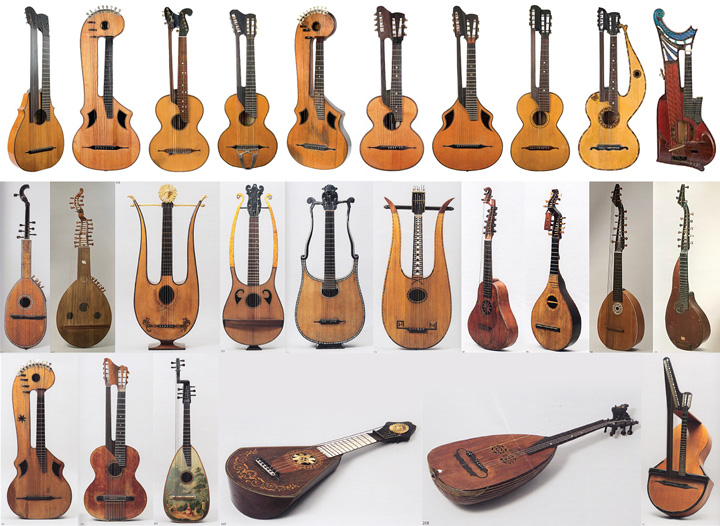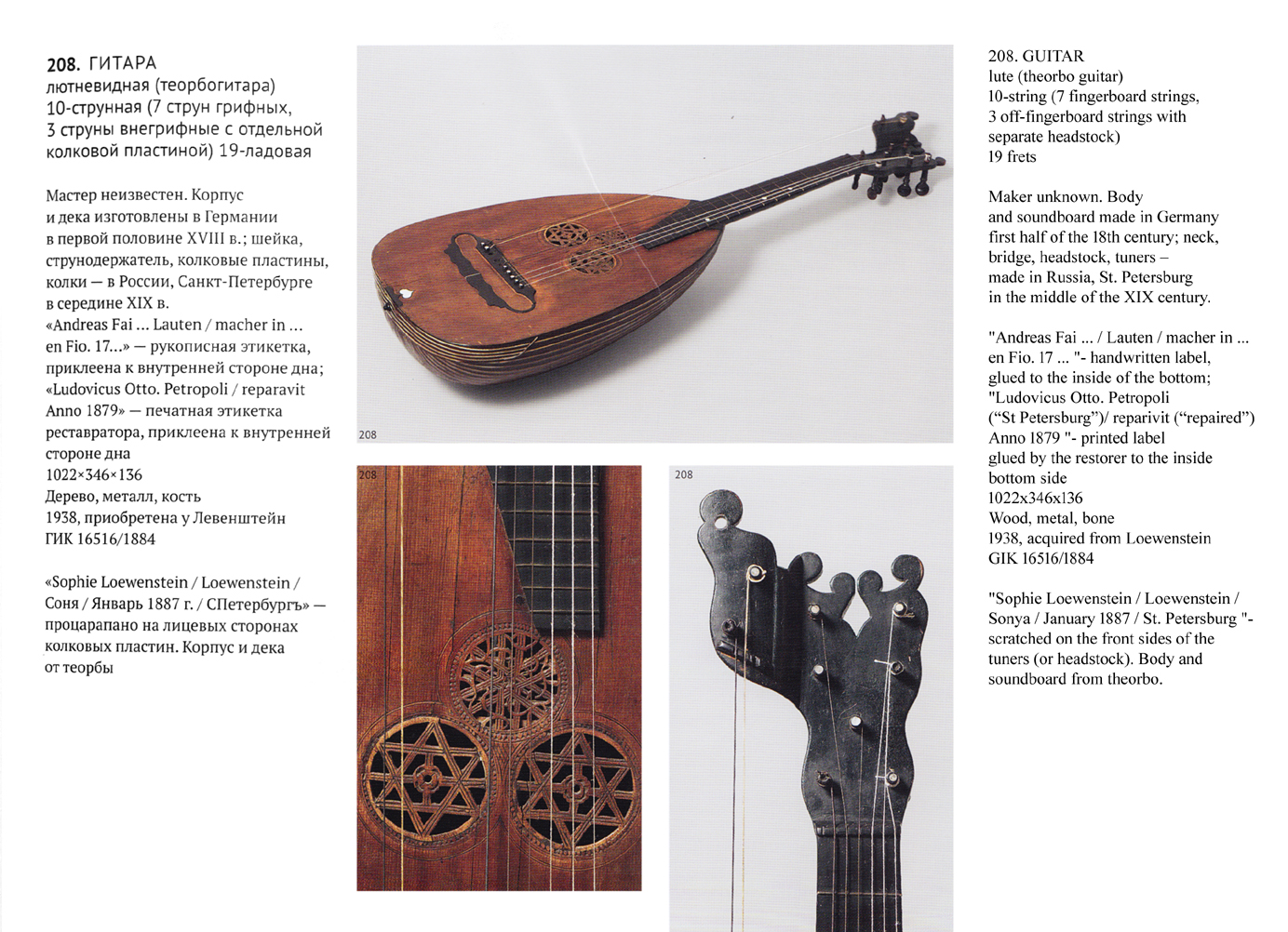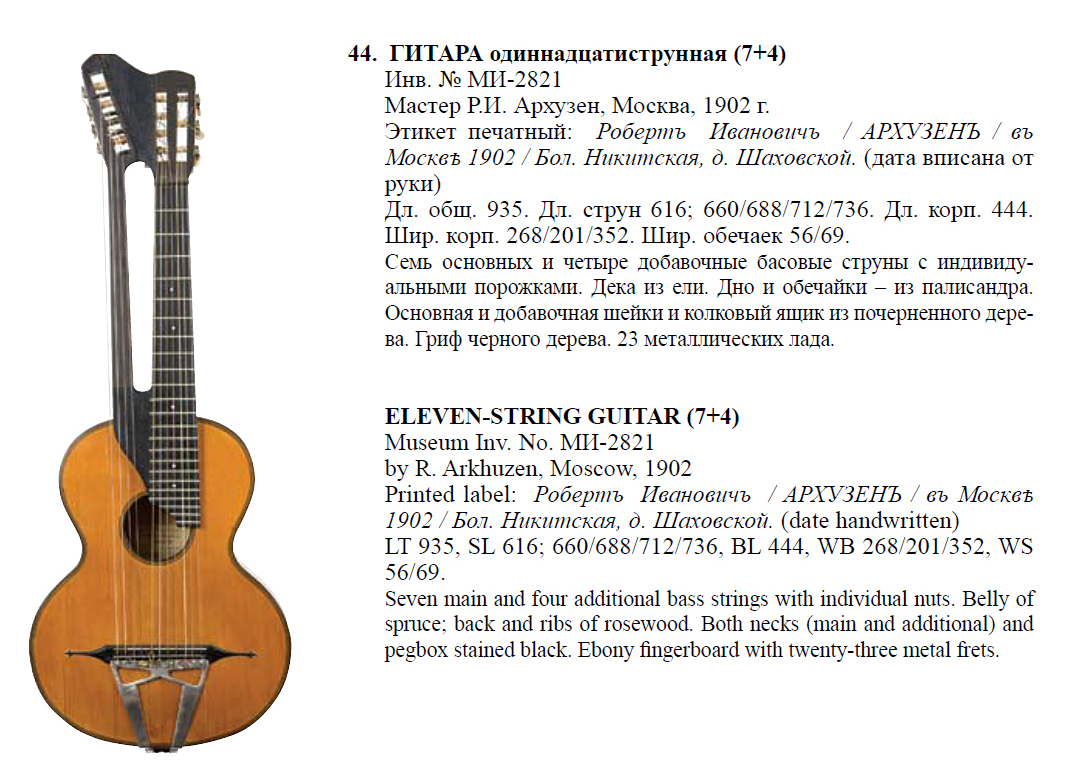
I suspect that few outside of Russia have seen the rare harp guitars and related instruments that I’m about to show. While there are many examples from European makers we’re already familiar with, there are more obscure treasures here, and yes, I am saving the best for last!
These instruments come from two major collections: one in Moscow’s Glinka National Museum Consortium of Musical Culture and the other in St. Petersburg’s State Museum of Theater and Musical Art. (All photo credits and copyrights held by those two institutions.) The former came (twice) in a 2013 PDF publication courtesy of my friends Jim Garber and Ilya Kryzhanovsky; the latter from a wonderful (and pricey!) book I won in the AMIS book auction during our 2017 Scotland convention. I’ll refer to the instruments below by their respective catalog numbers.
As the St. Pete book is entirely in Russian and obviously contained crucial details, I tasked my AMIS friend Matthew Hill (of the now-furloughed staff of the Bluegrass Museum) with the very tricky job of accurate translation of the detailed entries. This is harder than you think, especially when dealing with musical terms, and also depending on the context. For instance, did you know that the Russian term for fingerboard is also the word for “vulture”? (Now you do.) I could probably do an entire blog just on the fascinating process of the translations for this blog, but will leave that to Matthew for a future AMIS Newsletter article.


The most unusual instruments from the Glinka museum appear above, and are only shown at the end of their catalog with small images and little information. #148, made by G. Bobrovsky in 1935, would be a fairly basic Russian harp guitar (with 7 open-G-tuned neck strings) if it wasn’t for the additional hollow arm pasted onto the “wrong” side. It’s not the first guitar I’ve seen with this feature, and – for those who don’t like that arm in their face – is actually perfectly playable, and probably more comfortable for many players!
#149 was created by one M. Shtrianin in 1934 and is a 23-stringed (11+7+5) “zither-guitar.”
Next are full entries in both Russian and English.

The next Glinka specimens (#40 & 41, above and below) are a couple of bogengitarren by Friedrich Schenk of Vienna. My beginnings of a Schenk page on this site is here. The catalogs give “late 19th century” but Schenk was long gone by then.
 .
.
 #39 is a very distinctive Viennese wappen design by Franz Brunner. The catalog states “late 19th century” but I suspect this was built closer to 1850 (Brunner was born about 1824 and building by 1840 (?!).Note the 24 frets.
#39 is a very distinctive Viennese wappen design by Franz Brunner. The catalog states “late 19th century” but I suspect this was built closer to 1850 (Brunner was born about 1824 and building by 1840 (?!).Note the 24 frets.

#43 adds a new Russian maker to my Encyclopedia: P. V. Belov, who built his 4+7 harp guitar in Moscow in 1883.
Below, three more Russian harp guitars of traditional and wappen shape complete Glinka’s harp guitar catalog offerings: #44 by Moscow’s R. Arkhuzen in 1902, and two by M. Yeroshkin (#45 in 1904 & #46 in 1907).

One of the more interesting finds in the catalog was this 1862 “Scherzer” – who was of course the great Viennese builder of 9- to ?-string “bassgitarren.” I was immediately struck by its unusual one-off headstock design with sideways-tuning-buttons extension grafted onto a Stauffer-style headstock (which traditionally had the same button design). Expert Erik Hofmann suggests this is a later, non-original neck replacement on an original Scherzer body. No arguments here (though I wouldn’t put anything past Scherzer – see below…). Still, an interesting new dual-headstock design!
We travel now from Moscow to St. Petersburg for an even wider variety of plucked fretted instruments with floating strings and/or hollow arms.
First up are four rare forms of “arch-cittern,” all from the two decades centered around 1800.

#52 is the rare theorboed form of the guittar (or English Guitar), with 5 doubled fingerboard courses and 3 floating basses. Unmarked, the catalog states “France,” though I suspect it’s English.
#53 is common in Swedish collections: the “Swedish lute” (also based on the guittar’s open tuning) with 8 single fretted strings and 7 basses, which typically had a wonderfully complex “key changing” revolving nut apparatus, the frame of which is still present here. This one is unmarked.

#54 is the well-known Renault cittern (identical to the one in Boston’s MFA), and is the more unique flat-back model (I have a lute-back version of the same instrument).
#55 is one of my favorites – the super-rare and unusual variant of the French arch-cistre tuned like the guittar but in A. Renault of Paris built (and designed?) this one in the 1790s. The body extension is essentially a hollow arm stuck to the neck. One was famously owned by guitarist Napoleon Coste in his classic portrait (his includes his modified Lacote bridge):
![]()

Above: The museum has a couple harp-lutes; their unusual unmarked example of Levien’s “harp-guitar” or Guitare-Harpe shows how its 7th string (unlike inventor Light’s) was strung to float above the fretboard.
Curiously, the museum catalog includes just one typical Russian harp guitar: #181, an 1890s “F. S. Pasersky” with a crude replaced bridge and added tailpiece. Another curious addition is the Russian neck’s 7th string, which has been added to a 6-string headstock “after-market” via a friction tuner. The maker is the same “Paserbsky” (or “Passierbski”) who built Boris Perott’s instrument that I profiled here.

This museum also boasts a Schenk – #183 is his standard bogengitarre, though with an unusual extra star-shaped soundhole in the arm.

#207 is a strange catalog addition, as it’s a Franciolini-type Frankenstein’d instrument. I think it’s wonderful with its beautifully painted soundboard addition and its wacky new guitar neck – a theorbo extension in all right angles! The body is an original lute body labeled Joh. Christian Hoffmann, 1724, the alterations surmised as being late 1800s. A nightmare of a museum piece, I find it graphically fascinating.

#208 is another interesting re-purposed lute body and original soundboard (from the mid-1700s). This time, the guitar neck has the Russian tuning’s 7 strings, while the 3 basses are included in an interesting, almost Italianesque, theorboed headstock. Yet this was apparently done in St. Petersburg in the mid-1880s. The bridge’s additional separated pattern piece is nothing to celebrate – perhaps it hides a soundboard issue.
I’ve always included the wonderful world of lyre guitars as “distant hollow arm form cousins” on Harpguitars.net, and do so again here, as I’d never come across Russian-designed and built lyre guitars. These are all in the St. Petersburg museum.

First up (#318) is a typically gorgeous French model, complete with an “Apollo” ornament like the similar Apollo Lyre.
 .
.
These next two – #321 & 322 – are believed to be from the early 1800s. They have extremely delicate solid wood arms, the shapes of the tips and headstocks somewhat reminiscent of the altered lute above (perhaps this is then Russian-esque?). Both were made by the same anonymous Russian luthier, with one having a 6-string neck, the other the Russian’s seven. Dig the extra soundholes (do these suggest another Russian motif?). I’m actually surprised that the very practical idea of having a right hand palm rest floating above the strings and soundboard is something we don’t see more often – historically and today. I wish a bunch of my instruments had them!
More one-of-a-kind, fascinating lyre guitars:
 #326 was built in 1804 by German Carl Friedrich Schmuhl and has 6 strings tuned via wingnuts in a version of Preston’s guittar tuners. The decorations are incredibly distinctive if a tad incohesive.
#326 was built in 1804 by German Carl Friedrich Schmuhl and has 6 strings tuned via wingnuts in a version of Preston’s guittar tuners. The decorations are incredibly distinctive if a tad incohesive.

I rather like #327, another too-delicate “Don’t Touch” arm-extending idea. Also 1804, but Russian-made (with 7 strings on neck) by K. Layyshev in Moscow, repaired in 1858 by Arkhuzen.

.#474: An extremely stylized “modern-looking” torban by an unknown Russian or Ukraine maker from the early 1800s (a torban being a sort of lute/bandura hybrid with what we harp guitarists call sub-basses and super-trebles).

Another circa 1800 Russian torban (#487) with a more traditional appearance.
.OK, are you ready…?!

Made by the great J. G. Scherzer in Vienna, and, yes – real.
I was dying to know the story on this one, and the translation of #49 did not disappoint.
Some background: Johann Gottfried Scherzer was a pupil of the great J. Georg Stauffer (and worked for both father & son), and made arguably the best traditional Viennese guitars (and harp guitars) of the 1850s and ‘60s.
He also made the bizarre (and still not fully understood) experimental “Guitharfe” for mathematician Joseph Petzval in 1862.
This instrument was finished that same year and took over a year to deliver. This, the Petzval instrument, and an undiscovered 12-bass harp guitar built for Russian guitarist Sokolowski demonstrate that, at 60 years old, Scherzer was just getting his game on, with his instruments known throughout Europe and Russia. This was largely thanks to Makaroff, who awarded Scherzer his 1st Prize for Scherzer’s 10-string (harp) guitar in the important 1856 Brussels competition. Makaroff could have hardly imagined the bizarre inventions that others outside the guitar world would later commission the ahead-of-his-time Scherzer to realize!
Alongside Scherzer’s typical Margarethen label of the period, a second label inside the body tells the story:
(Translation) “I invented this guitar in the year 1860. On January 15, 1861 I sent a model and drawings to Vienna, (to the) famous guitarmaker Gottfried Scherzer, and on May 17th, 1862 received from him the guitar. – Vladimir Nikolaevich Davydov, Kursk province, Sudzhensk district, Sotny village.”
I asked my friend Ilya to investigate this V. N. Davydova, and after exhausting all sources, he found only one potential candidate: “The only Vladimir Nikolaevich Davydov from the Kursk region who is known in the cultural field of the 19th century and would be able to invent and commission the guitar (in view of his age) is the philosopher and sociologist V. N. Davydov, born in 1820 – but there is no indication that he was somehow related to the guitar.”
Matthew’s translated description reveals that that the body is just over 23-1/2” wide and the longest dimension is 55”. We can see an added frame around the outside of the top that supports the cross brace for the two necks, while the “inside of the instrument has violin construction and two struts/braces to prevent deformation of the body.” While it’s hard not to imagine the bridge pins popping out all over the place, antique harps use a similar system (with the strings in the opposite plane, but still coming off the soundboard at a steep angle) and they don’t have any problems. I imagine that that was the goal of this instrument: a louder, more resonant and – with the string/soundboard angle – truly harp-like tone (helped by a full 12 sub-basses). But that’s if one could figure out to play it. Despite its otherwise normal guitar and sub-bass necks and strings, there’s no way one could get in there with their left hand and fret this thing, is there? (I’d be tempted to lay it on the floor and try to crawl through it.) By the looks of it, I’m guessing that the inventor wasn’t actually musical himself. And if he was the philosopher and sociologist, where’d he come up with the funds to convince Scherzer to build a serious specimen of this white elephant?











FANTASTIC ! Wonderful photos and personal comments, not just a museum but a guided tour. Thank you